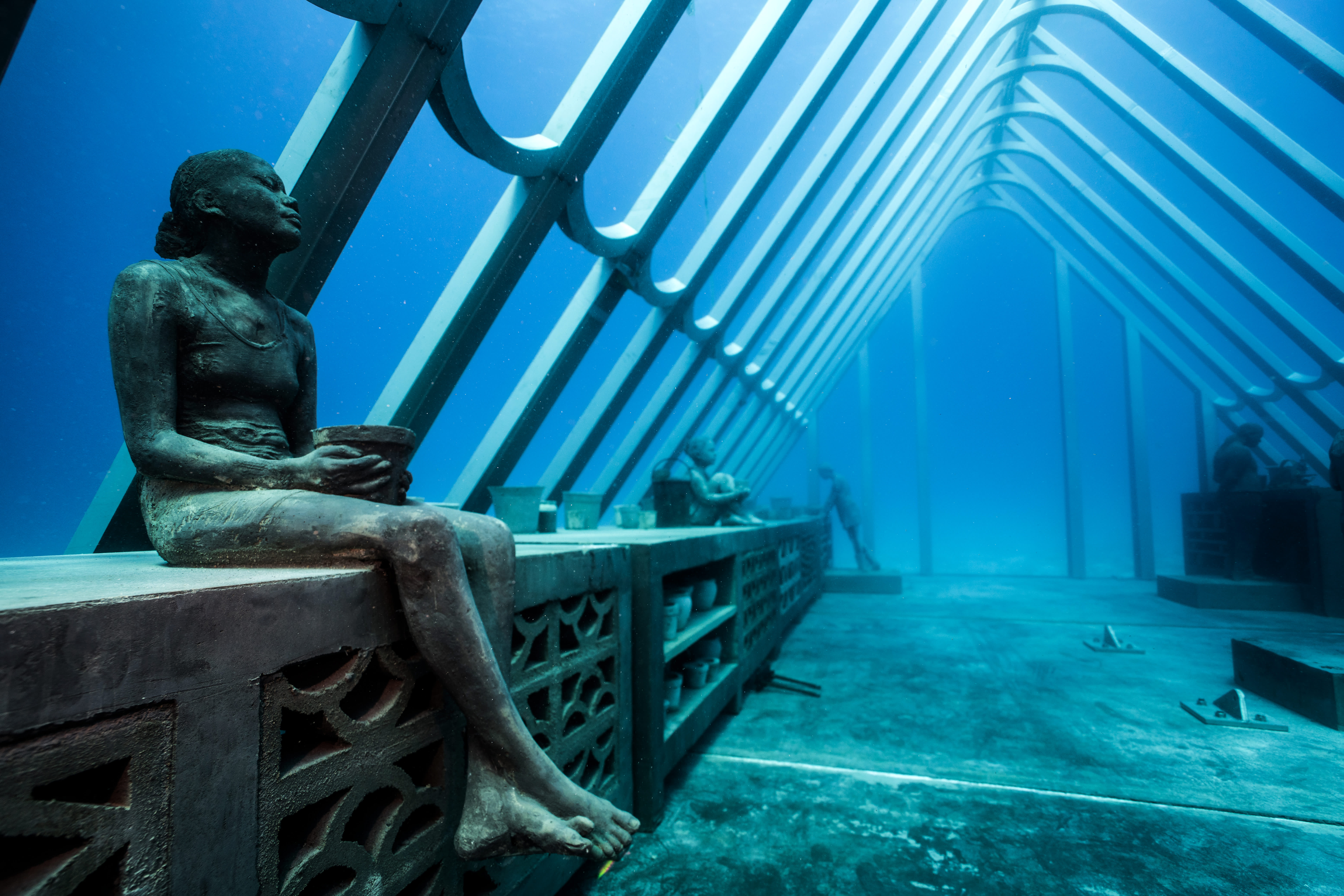Works of art can be found everywhere, from airplane art galleries flying through the sky to the snow-covered tundra of Antarctica and Banksy’s bathroom — the latter being the artist’s latest shelter-at-home creation.
But what about inside the vast ocean blue?
A statue that changes color with the sea water
Townsville’s Strand Jetty has always been a popular spot for visitors to Queensland, Australia. Part of a 1.5-mile waterfront, there are cafes, ice cream parlors and the Strand Water Park along its length. But now it offers another reason to walk to its conclusion.
“Ocean Siren,” a statue modeled after 12-year-old Takoda Johnson, towers above the ocean’s surface. The young girl is a member of the local Wulgurukaba people, one of two traditional owners of the local land.
“Ocean Siren” — modeled after a young Wulgurukaba girl — changes color to reflect the water temperatures.
Jason deCaires Taylor
“She looks over the land of her forefathers,” said sculptor Jason deCaires Taylor, who arrived in North Queensland to become a scuba diving instructor after graduating from the London Institute of Arts in 1998. He created the 16-foot-tall sculpture in collaboration with Townsville’s James Cook University and the Australian Institute of Marine Science.
The sculpture changes color according to the ocean’s temperature using data collected by the Davies Reef weather station. The data is collected from sensors affixed throughout the Great Barrier Reef. The ever-changing, solar-powered sculpture is a reminder and warning about the Earth’s rising sea temperatures.
“I was keen to show what’s happening out on the reef in an urban environment, so it connects the community to the reef,” said Taylor.
An art installation on the ocean floor
The gleaming statue is just one of four projects that make up the Museum of Underwater Art (MOUA). Another installation lies at the heart of the Great Barrier Reef, about two hours from Townsville by boat.
A scene from “Coral Greenhouse” which encourages reef awareness and interest in marine science.
Jason deCaires Taylor
“Coral Greenhouse” at the John Brewer Reef is MOUA’s largest installation. The submerged site was chosen for its clear visibility, natural coral walls and sandy, flat base. The installation was completed in December 2019 and was scheduled to open this month, but due to coronavirus-related restrictions in Queensland, the opening date has been postponed. When it launches, tour operators will take divers and snorkelers to explore the art project located around 60 feet under the sea.
Within the installation’s 40-foot-long skeletal structure, which was designed to dissipate the ocean’s strong undercurrents, are 20 statues of students working with coral.
“When we talk about reefs, we’re very much talking about what we’re leaving for younger generations,” explained Taylor. “I also wanted to encourage more youth into marine science and into exploring and understanding the underwater world. Plus, I wanted the local communities — school students, especially — to become ambassadors for the reef, almost like guardians with a keen interest in how it evolves.”
As well as being a strong tourism draw and a habitat for marine creatures, the artwork functions as a laboratory. Water salinity, pH and oxygen levels are monitored, and an underwater camera captures the development of the corals.
Taylor held workshops with local artists and members of the indigenous community in the months leading up to its construction and installation. Before it was introduced to the ocean, the sculpture comprised about 500 steel and concrete parts that were assembled into five large sections for installation on the ocean floor.
“Coral Greenhouse” weighs around 64 tons and was built to withstand a Category 4 hurricane.
Richard Woodget
“This is one of the heaviest installations I’ve ever done,” said Taylor of the 64-ton creation. “It was very important as part of the permitting process that it was extremely well anchored to the sea floor. We had to ensure it was resistant to a Category 4 cyclone.”
Though two more installations aren’t scheduled to be completed until the end of 2021 — one at Queensland’s Palm Island and other at Magnetic Island — the Queensland government expects MOUA to become a major tourism attraction in the coming years.
Other underwater museums around the world
Though it’s a Southern Hemisphere first, MOUA isn’t the world’s first underwater museum nor is it Taylor’s first time submerging his work.
His first underwater attraction was launched in 2006 off the coast of Grenada. Located at a depth of 16 feet, Molinere Underwater Sculpture Park features 75 works including “Vicissitudes,” which shows a ring of 26 children that symbolizes the circle of life and the importance of creating a sustainable environment for generations to come.
“Vicissitudes” at Grenada’s Molinere Underwater Sculpture Park.
Jason deCaires Taylor
Since then, Taylor launched Mexico’s Museo Subacuático de Arte off the coast of Cancún, with more than 400 individual statues that create a unique artificial reef; The Bahamas’ Ocean Atlas, the largest single underwater sculpture anywhere in the world; Spain’s Museo Atlántico within the Lanzarote Biosphere Reserve; and the Coralarium near the island of Sirru Fen Fushi in the Maldives’ Shaviyani Atoll.
Museo Atlántico is located in Lanzarote’s UNESCO World Biosphere Reserve.
Jason deCaires Taylor
The Queensland project has one very big distinction when compared with Taylor’s other reef designs.
“In the past, it’s been about drawing tourists away from reefs. In the Caribbean, for instance, there are very few pristine reefs left,” he said. “This project was about drawing people out to the reef to showcase how it is still in fantastic condition and has some of the most amazing corals in the world.”
“The Silent Evolution” at Mexico’s Museo Subacuático de Arte.
Jason deCaires Taylor
“There’s a misconception that all of the Great Barrier Reef is bleached, and that’s very much not the case. The particular reef we’re working on is one of the best reefs I’ve seen in the world.”
